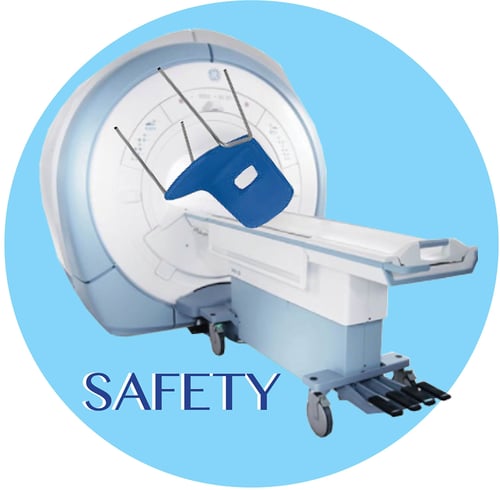There are 40 million MRIs done annually in the United States, so it makes sense that establishing safety protocols and guidelines in MRI environments is important. According to Emanuel Kanal, M.D. and Professor of Radiology and Neuroradiology and Director of MR Education and MR Services at the University of Pittsburgh Medical Center, it’s often the lack of knowledge about safety protocols and guidelines that lead to incidents.
in MRI environments is important. According to Emanuel Kanal, M.D. and Professor of Radiology and Neuroradiology and Director of MR Education and MR Services at the University of Pittsburgh Medical Center, it’s often the lack of knowledge about safety protocols and guidelines that lead to incidents.
He said, “Unlike most surgery or many medications, MRI, while complex, carries very little risk, is relatively safe, and is invaluable to the diagnosis and treatment of patients. However, when someone is hurt during MRI, the injury was almost always avoidable.”
Reducing the Incidents of MRI Burns
Being able to prevent MRI injuries involves understanding the modality and how it can cause harm. When it comes to MRI, the most frequent injury is second-degree burns. These burns can occur in a variety of ways, but it is especially common when a patient comes in contact with the bore during an MRI scan.
Robert E. Watson, Jr., MD, PhD, Associate Professor of Radiology at Mayo Clinic, Rochester, MN, Chair of the American Board of MR Safety (ABMRS), and Chair of the American College of Radiology (ACR) MR Safety Committee said, “A bedsheet alone won’t protect a patient from near field burns; you must use insulated pads that are about an inch thick to ensure the patient isn’t burned due to unsafe proximity to the bore.” He continued, “This is especially important if the patient is under anesthesia. If insulating padding slips out of place as when the patient is being advanced into the magnet, a body part could contact the bore and a severe burn could result, especially since the anesthetized patient won’t react to the heating.”
Watson reminds technologists and radiologists to make sure patients’ thighs or other body parts aren’t touching because points of skin-to-skin contact can be sites of heating and burns due to RF energy-induced current loops within a body. This is also true if leads or wires in the bore touch the patient’s skin.
MRI burns also occur when patients don’t change into gowns approved by hospitals before entering the MRI Scanner. Colin Segovis, MD, PhD, Director of MRI Quality and Safety and Assistant Professor of Radiology and Imaging Sciences at Emory University School of Medicine, Atlanta said “Today, fabrics used for undergarments and athletic clothing are made with copper fibers meant to hide odor,” Segovis explained. “In the MRI, metallic fibers burn patients, so it is important that they put on approved clothing prior to a scan.”
Reducing Projectile Incidents in MRI
Projectiles are another cause of MR-related deaths and injuries. These incidents can occur when ferromagnetic objects are pulled across the room toward an MRI scanner at high speeds and collide with someone in the room. This can be an oxygen cannister or other ferromagnetic object.
Segovis added, “An MRI scanner is an incredibly powerful magnet, and the magnet is always on even if the machine isn’t running. This is such an important awareness and safety concept to ensure that anyone who works in the imaging suite understands.”
Watson also pointed out the importance of establishing protocols around MRI safety zones. These four zones are:
MRI Zone 1: These areas are freely accessible to the health care team members, the general public and patients without supervision. The magnetic fringe fields in these areas are very low to none.
MRI Zone 2: This is also a public area. It’s usually for MRI patient screening and preparation but is getting closer to Zones 3 and 4.
MRI Zone 3: This is a restricted area with access for screened patients and health care team members only. It’s near the magnet room and can potentially present a physical hazard to those unscreened.
MRI Zone 4: This is often called the “magnet room,” and houses the MRI. It has the highest strength magnet fields as well as the greatest risk for hazards.
Watson added, “Zone 4 houses the MRI itself, and it can be thought of as the ‘magnet room’ and the ‘projectile zone.’ If someone walks into Zone 3 with an unsafe ferromagnetic object and the door to Zone 4 is open and unprotected, this sets the stage for a serious projectile incident. Appropriate use of ferromagnetic detection systems can help lessen this risk.”
Implanted Devices Are Also A Concern
It’s important for radiologists to be aware of devices that are implanted in a patient’s body, as they can endanger a patient’s life. When you consider that up to 75% of patients with cardiac implanted devices like defibrillators and pacemaker will need an MRI during their lifetime, it’s obvious that radiologists must have safety protocols in place for MR.
There are three types of implanted devices: MRI Safe, MRI Unsafe and MRI Conditional. Many of these devices have been MRI Unsafe in the past, but newer ones have MRI conditional labeling now. And there is actually growing evidence that patients with cardiac devices labeled MRI Unsafe could be scanned in a controlled environment.
Stephanie Tan, MD, a thoracic radiologist at the Montreal Heart Institute, said, “In order to enter Zone 4, pacemakers need to be set to MRI-safe mode. Hospitals and imaging centers should have protocols in place where the cardiologist adjusts the settings on patients’ pacemakers before and after each scan to ensure patient safety.”
MRI Safety Awareness Is Key
Burns, projectiles and implanted devices are the most reported causes of MRI-related injuries and deaths. Many radiologists believe that the real underlying danger is the lack of MRI safety education, communication and standardization. The RSNA and many organizations and societies now include dedicated MR safety sessions in their annual meetings. In addition, the ACR MR Safety Committee updates its Manual on MR Safety and the American Board of Magnetic Resonance Safety provides formal exams for candidates to demonstrate their knowledge regarding specific MR safety roles.
Kanal added, “Although injuries rarely happen, when they do, people are injured unnecessarily. The key to avoiding these risks is education and standardization.”
Talk To An Expert
Do you need a new MRI Scanner or other medical imaging equipment? Talk to the experts at Atlantis Worldwide. Oftentimes a refurbished or used system can provide the performance you want at a much lower price point—and still deliver a great service warranty. Atlantis Worldwide has been helping healthcare providers, clinics, hospitals, urgent cares and veterinary clinics with medical imaging solutions for almost 30 years and we’d love to help you.
Some blogs you may have missed:
- The Future of Helium & MRIs
- MRI Cold Head Tips
- Service Contracts for Imaging Systems: Penny Wise and Pound Foolish?
- Radiologists, Healthcare & Social Media
- Should your business lease or buy medical imaging equipment?
- Free MRI Resources
Meet the author: Vikki Harmonay



